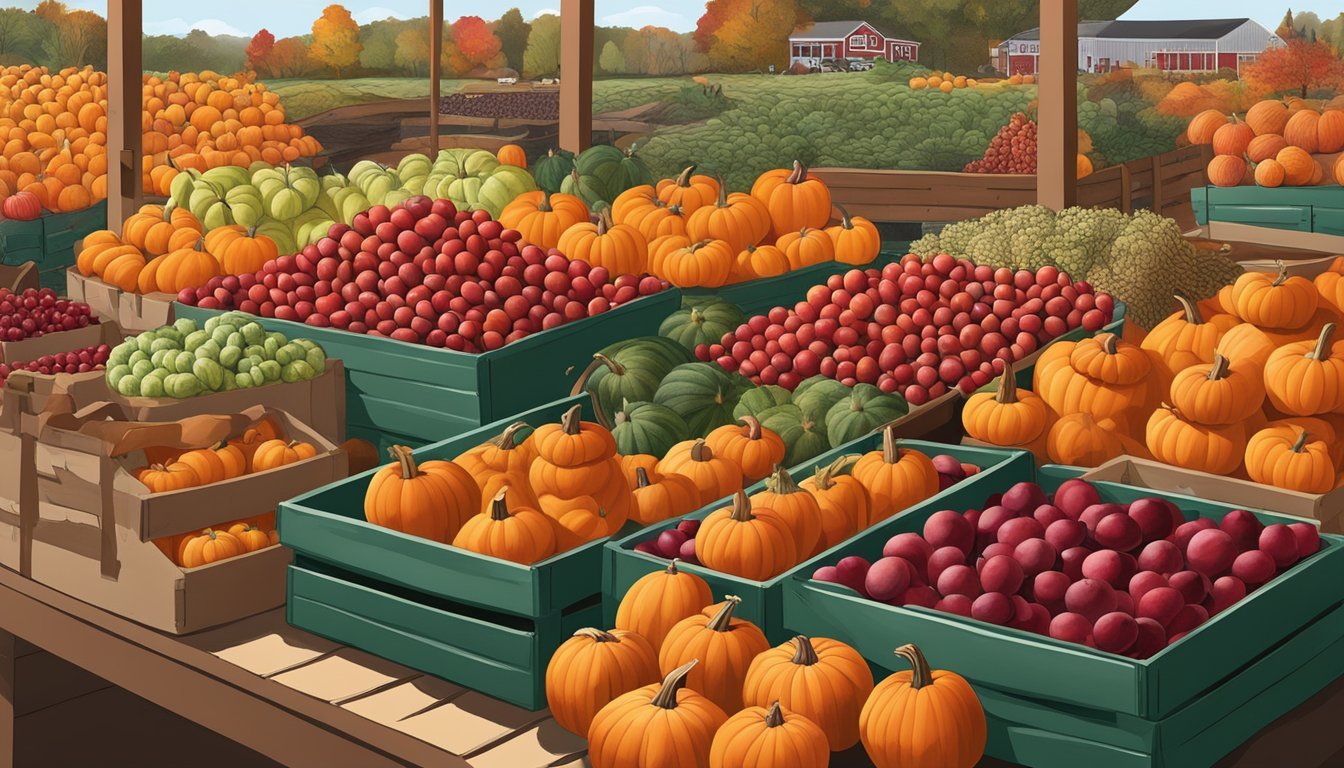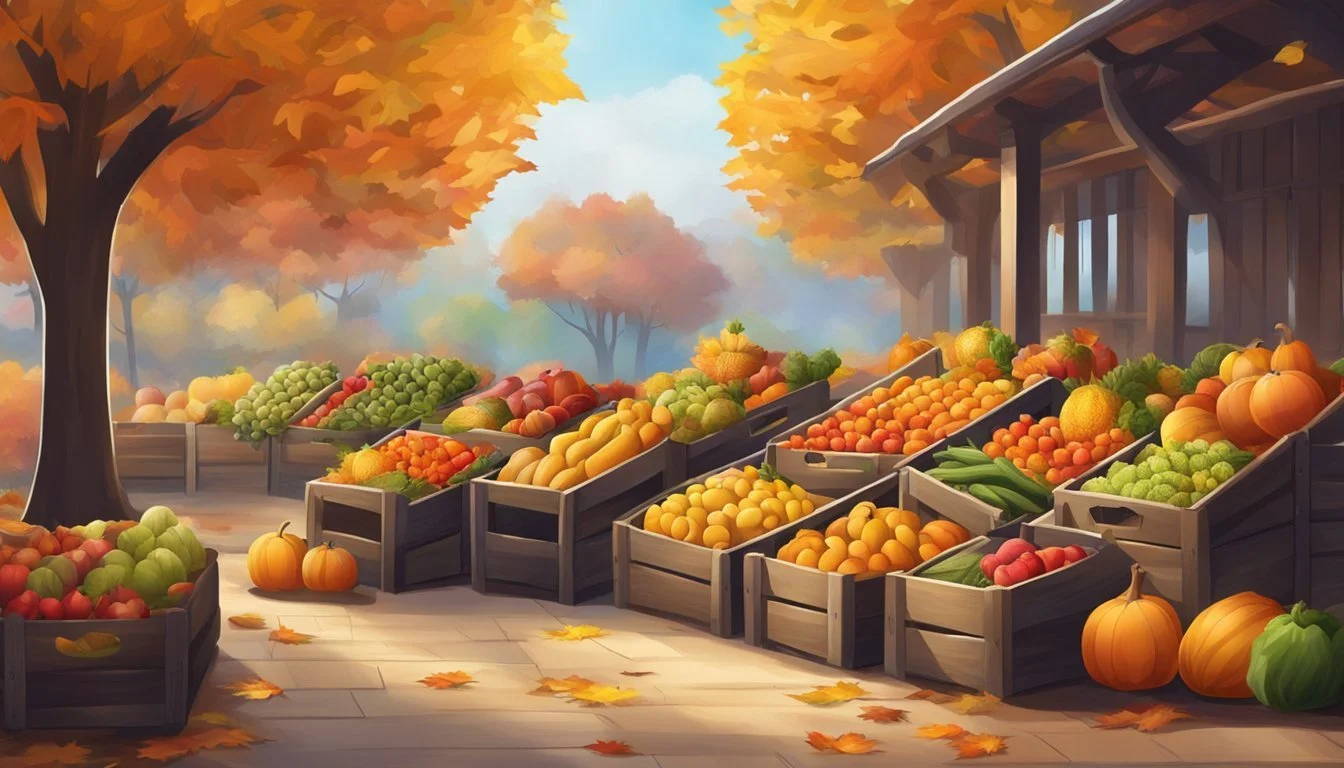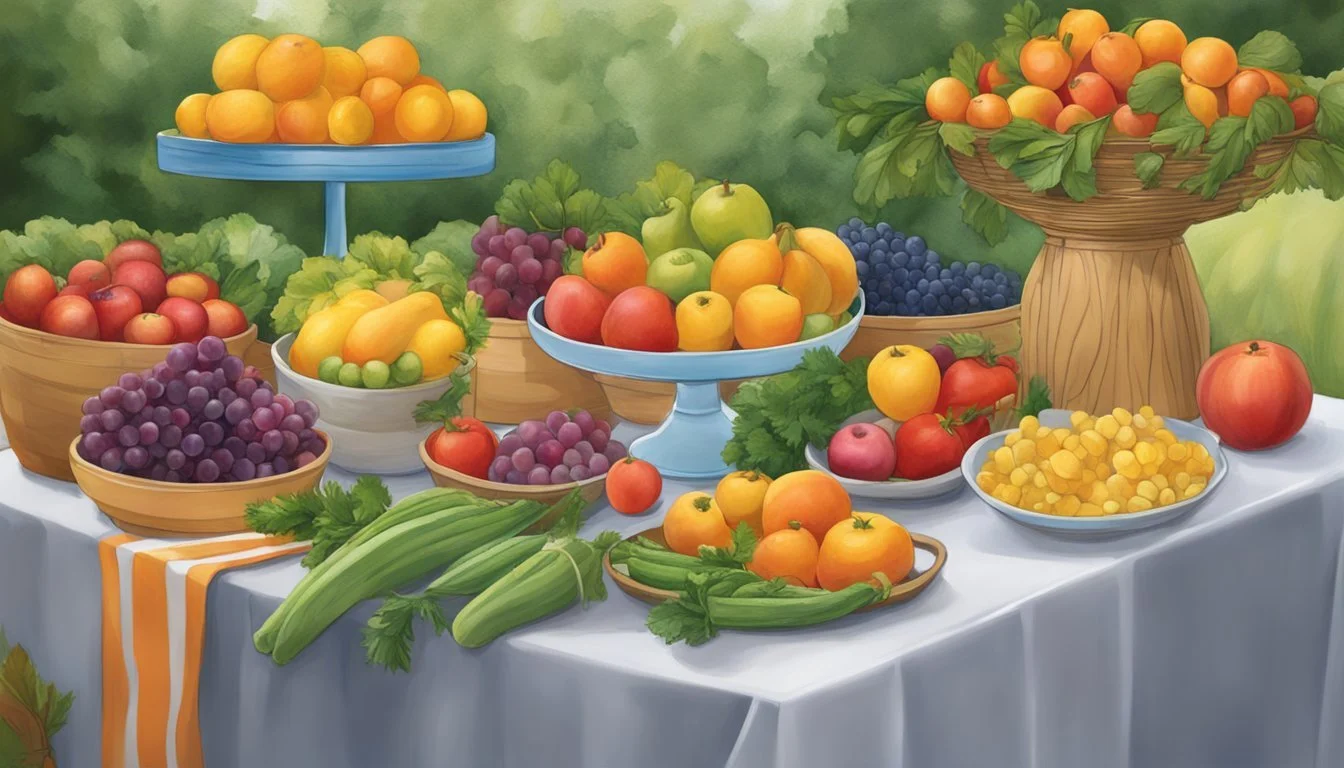New Hampshire Seasonal Fruit & Vegetables in November
A Guide to Autumn Harvest
This Article is Part of our New Hampshire Seasonal Fruit & Veg Calendar
In the brisk month of November, New Hampshire's fields and orchards transition from the rich variety of late summer bounty to the hardier selections suited to colder weather. Winter squashes and root vegetables take center stage as the staples available during this time, reflecting the state's adaptation to its shorter growing season compared to other regions in the United States. Farmers and gardeners throughout the Granite State harvest and offer a range of produce that withstands the cooler temperatures, providing fresh, locally-grown options even as the first frosts arrive.
The availability of fresh produce in New Hampshire during November is bolstered by the use of greenhouses, which extend the growing season beyond what the natural climate allows. This integration of technology in agriculture enables the state to supply a variety of greens and other vegetables that would otherwise not withstand the descending temperatures. Consumers benefit from this extension, savoring the tastes of fresh vegetables that would typically be out of season in the region's outdoor conditions.
Understanding New Hampshire's Growing Seasons
New Hampshire experiences four distinct growing seasons, each with its characteristic produce. The state’s geographical location and climate influence the variety and availability of fruits and vegetables throughout the year.
Spring marks the beginning of the growing season. As the snow melts and the ground thaws, early crops like rhubarb and asparagus (how long does asparagus last?) emerge. The length of daylight increases, signaling the start of a new harvest period.
During summer, the combination of warm temperatures and longer days allows a wider variety of crops to thrive. This season is the peak for farming activities, yielding an abundance of produce, including berries, peaches, and tomatoes.
As fall approaches, the focus shifts to cool-weather crops. The harvest continues with robust offerings such as apples and pumpkins, which can withstand the cooler temperatures. This is also the time for late plantings that will mature before winter sets in.
Winter in New Hampshire is generally a dormant period for growth due to cold temperatures and frost. However, certain hardy vegetables, like root crops and winter greens, can still be available thanks to greenhouse growing and improved storage techniques. The state's farmers markets and local food systems also work to extend the availability of New Hampshire’s produce.
Here is a brief list of typical produce available by season:
Spring: Asparagus, Rhubarb
Summer: Berries, Peaches, Tomatoes
Fall: Apples, Pumpkins
Winter: Stored root crops, Winter greens
One must note that weather patterns can affect the precise timing and quality of the harvest in New Hampshire, as in any agricultural area.
Overview of November Produce
November in New Hampshire marks a transitional period where the harvest focuses on hearty produce that can withstand the cooler temperatures. This shift in the season brings a bounty of both fruits and vegetables that are prime for picking and enjoying during this month.
Fruits in November
Apples continue to be a staple in New Hampshire's November harvest, with variety types perfectly suited for pies, ciders, and fresh eating. Trees yield fruits such as McIntosh and Cortland, cherished for their balance of sweet and tart flavors. While not as abundant as apples, cranberries also feature in November's produce, integral to Thanksgiving celebrations and autumnal recipes.
Vegetables in November
The vegetable harvest in November boasts a variety of root vegetables and squashes. Staples include:
Butternut Squash: (how long does butternut squash last?) Sweet and nutty, versatile for soups and roasting.
Acorn Squash: Known for its sweet, buttery flavor, great baked or stuffed.
Brussels Sprouts (how long do brussels sprouts last?): Maturing in the cool weather, they turn sweeter after a frost.
Parsnips: With a sweet, earthy taste, they are ideal for roasting or in stews.
Sweet Potatoes: A November favorite, nutritious and filling, perfect for a multitude of dishes.
Turnips: Their flavor enhances with the cooling temperatures, used in soups and side dishes.
Seasonal Highlights in November
In November, New Hampshire's harvest is rich with the last of the fall fruits and an abundance of hardy root vegetables that thrive in the chill of early winter. Markets often feature locally-grown, crisp apples, a variety of root vegetables, and hearty winter squash, all of which can be found in abundance this month.
Apples
New Hampshire offers a range of apple varieties in November. Expect to find types such as McIntosh and Cortland, which are perfect for both eating raw and using in pies and sauces due to their balance of sweet and tart flavors.
Root Vegetables
Carrots (how long do carrots last?)and beets are at their peak, displaying deep, vibrant colors and full flavors. Carrots harvested in November tend to be sweeter, making them ideal for both savory dishes and desserts. Beets, with their earthy taste, are excellent for roasting or boiling.
Carrots: Sweet, crisp, ideal for roasting
Beets: Earthy flavor, versatile in cooking
Winter Squash
The season's winter squash, including varieties such as butternut, acorn, and pumpkin, are staples in November. They offer a sweet, nutty flavor that is synonymous with autumn and are often used in soups, stews, and baked goods.
Butternut Squash: Smooth texture, sweet taste
Pumpkin: Perfect for pies, roasting, and soups
Planting and Harvesting Cycle
In New Hampshire, November is a transitional period where the focus shifts from planting to harvesting the season's bounty. This time is characterized by preparing for winter and collecting the last yields of fall vegetables and fruits.
Fall Planting
In November, fall planting is generally wrapped up due to New Hampshire's cold climate. However, gardeners sometimes plant garlic and winter wheat which will overwinter and sprout in spring. The essential factor is the timing: these crops must be planted early enough to establish roots before the ground freezes yet late enough that they don’t sprout too soon and suffer from winter kill.
November Harvesting
Harvest activities in November center on the collection of late-season crops that thrive in the cooler temperatures. Gardeners harvest:
Root vegetables such as carrots and beets
Brassicas like kale, brussels sprouts, and cabbage
Hardy greens including spinach and collards
Winter squash and pumpkins that have been left in the fields to cure
The harvest season for fruits has mostly concluded by November, but some apple varieties can still be collected if they have not yet been subjected to a hard freeze. Gardeners use this time to clear out annual beds, compost plant debris, and mulch perennial crops to protect them from the cold.
Health Benefits of Seasonal Eating
Eating seasonally involves selecting fruits and vegetables that are naturally grown and harvested at their peak in one's local region. For New Hampshire residents, engaging in seasonal eating in November means enjoying a plethora of locally grown produce that is fresh, flavorful, and nutrient-dense.
Local and Fresh: Seasonal produce in New Hampshire doesn't travel far, which means it is fresher when it arrives on the plate. Freshness is known to be a key factor in preserving the nutritional value of fruits and vegetables, as essential vitamins and minerals can degrade over time and during long transits.
Nutritional Value: Consuming fruits and vegetables at their seasonal peak ensures an optimal level of nutrients. This is because the produce is allowed to ripen naturally rather than being harvested early for transportation. For example, a ripe, locally sourced apple from New Hampshire in November may offer a rich supply of vitamins and antioxidants that contribute to overall health.
Immune Support and Health: The immune-boosting properties of fresh produce are vital, especially as winter approaches. Local, in-season vegetables can provide higher levels of certain vitamins that are essential for maintaining immune function.
Sustainable Benefits: Seasonal eating supports local agriculture and reduces carbon footprint due to shorter transportation distances. It indirectly promotes a healthier environment by lessening the reliance on imported produce.
Dietary Variety: Each season brings a unique variety of fruits and vegetables, which encourages a diverse diet. This dietary diversity is important for gut health and can reduce the risk of chronic diseases by supplying a range of phytonutrients and fibers.
In summary, partaking in seasonal eating by choosing local, seasonal fruits and vegetables in November, not only supports the health of individuals in New Hampshire but also contributes to environmental sustainability and the local economy.
Local Agriculture and Economy
New Hampshire’s local agriculture is a significant contributor to the state’s economy. November in New Hampshire marks the end of the harvesting season for many crops, but local produce such as apples and pumpkins are often still available. The agriculture sector benefits the state economy by not only providing jobs but also by supporting ancillary businesses such as farm equipment suppliers and food processing companies.
In this period, farmers' markets and CSA programs (Community Supported Agriculture) are winding down for some crops yet remain active for those that thrive in the cooler weather. The agricultural output of New Hampshire in November tends to emphasize such cold-hardy produce and remaining root vegetables.
Here is a breakdown of typical available produce in November:
Fruits: Apples, Pears
Vegetables: Pumpkins, Winter squash, Turnips, Rutabagas, Carrots, Beets
Agriculture in the state is known for its small-scale and diversified farms, which often adapt quickly to market demands and climatic changes. The short growing season and the variety of microclimates across the state require a resilient approach to farming.
The local economy is also strengthened by agritourism, which peaks in the fall with activities such as apple-picking and hayrides. This influx of visitors provides additional revenue streams for farmers and promotes the state’s agricultural heritage.
By prioritizing locally grown produce, New Hampshire not only bolsters its economy but also reduces food miles, ensuring a fresh supply of seasonal produce to its residents while supporting sustainable agricultural practices.
Storing and Preserving Tips
In November, New Hampshire's harvest brings a variety of fruits and vegetables that can be stored or preserved. Here are effective methods to ensure these foods maintain their quality and nutritional value during the cold months.
Freezing and Canning
When preserving fresh produce, freezing is a straightforward approach. For best results, blanch vegetables like squash and beans before freezing to preserve color, texture, and flavor. Fruits can be frozen whole or in slices with a sprinkle of sugar to retain their taste. Canning, following USDA guidelines, is ideal for making jams, jellies, and preserves from November's harvest of apples, pears, and late berries. Safe canning practices involve using a pressure canner for low-acid foods to prevent the risk of foodborne illness.
Root Cellars
Root cellars provide a natural and energy-efficient method of storing harvested crops. In a root cellar, fruits such as apples and pears should be stored on shelves in a single layer, while root vegetables like carrots and turnips should be kept in bins with damp sand to maintain humidity levels. Regularly check for any signs of spoilage to ensure the longevity of stored produce.
Preparing Seasonal Dishes
In November, New Hampshire's markets brim with a variety of seasonal produce that can inspire numerous warming dishes. Home cooks and chefs alike take advantage of these fresh ingredients to create meals that reflect the season's abundance.
Vegetables such as parsnips, carrots, and Brussels sprouts take center stage. They can be roasted to bring out their natural sweetness, an ideal side dish for any hearty meal. One can toss them lightly in olive oil, salt, and pepper, then roast at 400 degrees Fahrenheit until caramelized.
Fruits, particularly apples, remain a staple in November. They can be used in both savory and sweet contexts. Apple pie, a classic American dessert, showcases the versatility of New Hampshire's apples. The key to a great apple pie lies in the balance of apple varieties; using both tart and sweet apples can yield a more complex flavor.
Seasonal Recipe Ideas Roasted Root Vegetables Caramelized Brussels Sprouts Rustic Apple Pie Carrot and Parsnip Soup
Fresh herbs, although limited, still play a significant role in November dishes. Thyme and parsley can be harvested and add a fragrant touch to soups and stews. Integrating these herbs enhances the depth and character of the meal.
The secret to preparing outstanding seasonal dishes is the simplicity of the recipes that spotlight the natural flavors of the ingredients. Whether it's the earthy richness of roasted roots or the sweet tang of baked fruits, November's palette of flavors is a testament to New Hampshire's seasonal produce.
Gardening Tips for November
As the New Hampshire chill sets in during November, gardeners must pivot their strategies to protect their yields and plan for greenhouse cultivation.
Protection from Pests
In preparation for winter, gardeners should shield trees and shrubs from pests like voles. The use of ¼ inch galvanized hardware cloth formed into cylindrical guards around plant bases is an effective deterrent. These small rodents are capable of extensive damage if not properly managed.
Voles: Compact rodents known to damage plants during colder months.
Prevention: Wrapping plant bases with galvanized hardware cloth can prevent vole damage.
Greenhouse Growing
Greenhouse environments offer controlled conditions for cultivating vegetables that are less tolerant of the cold New Hampshire climate. In a greenhouse, gardeners can maintain a productive vegetable plot into the late fall and early winter months.
Temperature: Maintain an adequate and consistent temperature conducive to plant growth.
Plant Selection: Choose vegetables capable of thriving in greenhouse environments during November.
Key Vegetables for Greenhouse Growing in November:
Lettuce
Radish
Spinach
By focusing on pest protection and the microclimate of a greenhouse, gardeners can extend their growing season and safeguard their gardens from the challenges November brings.
Challenges and Considerations
In November, New Hampshire's fruit and vegetable growers face unique challenges due to weather conditions and pest management issues specific to the late fall season.
Weather Impact
The weather in New Hampshire during November brings colder temperatures and the first frosts, which present considerable challenges for maintaining fruit and vegetable crops. Colder temperatures can accelerate the end of the growing season for many crops, while early frosts can damage or completely kill sensitive plants. Growers must closely monitor the forecast and employ protective measures such as row covers or high tunnels to extend the harvest period for crops like kale, carrots, and brussels sprouts.
Protective measures: Row covers, high tunnels
Vulnerable crops: Kale, carrots, brussels sprouts
Pest Management
Even in November, pests and diseases remain a concern for New Hampshire producers. Pest management strategies need to adapt to the changing conditions, as cooler weather can affect the behavior and life cycle of pests. Disease pressure often decreases with the onset of cold weather, but crops weakened by the cold may become more susceptible to certain pathogens. Growers must remain vigilant and continue to apply integrated pest management (IPM) practices to minimize crop losses.
Common pests: Aphids, mites
IPM strategies: Scouting, selective pesticide use










